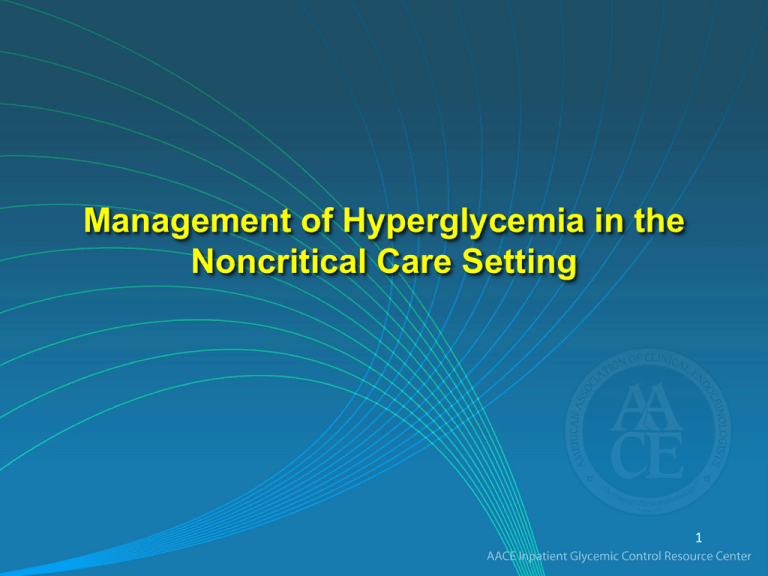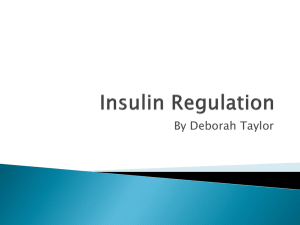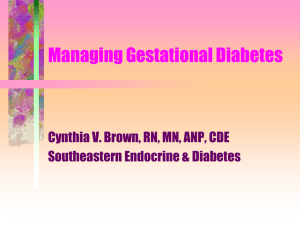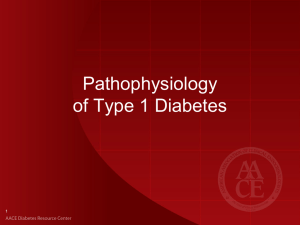Management of Hyperglycemia in the Noncritical Care Setting
advertisement

Management of Hyperglycemia in the Noncritical Care Setting 1 RECOGNITION AND DIAGNOSIS OF HYPERGLYCEMIA IN NONCRITICALLY ILL PATIENTS 2 Number of US Hospital Discharges With Diabetes as Any-Listed Diagnosis 196.4% From 1988 to 2009, the number of hospital discharges with diabetes as any-listed diagnosis increased from 2.8 million to nearly 5.5 million. CDCP. Diabetes Data and Trends. Available at: http://www.cdc.gov/diabetes/statistics/dmany/fig1.htm. 3 Distribution of Patient-Day-Weighted Mean POC-BG Values for ICU ~12 million BG readings from 653,359 ICU patients; mean POC-BG: 167 mg/dL. Swanson CM, et al. Endocr Pract. 2011;17:853-861. 4 Recognition and Diagnosis of Hyperglycemia and Diabetes in the Hospital Setting • All patients – Assess for history of diabetes – Test BG (using laboratory method) on admission independent of prior diagnosis of diabetes • Patients without a history of diabetes – BG >140 mg/dL: Monitor with POC testing for 24-48 h – BG >140 mg/dL: Ongoing POC testing – Patients receiving therapies associated with hyperglycemia (eg, corticosteroids): monitor with POC testing for 24-48 h • BG >140 mg/dL: continue POC testing for duration of hospital stay • Patients with known diabetes or with hyperglycemia – Test A1C if no A1C value is available from past 2-3 months BG, blood glucose; POC, point of care. Moghissi ES, et al. Endocrine Pract. 2009;15:353-369. Umpierrez GE, et al. J Clin Endocrinol Metab. 2012;97:16-38. 5 Recognition and Diagnosis of Hyperglycemia and Diabetes in the Hospital Setting Upon admission • Assess all patients for a history of diabetes • Obtain laboratory blood glucose testing No history of diabetes BG <140 mg/dL (7.8 mmol/L) No history of diabetes BG >140 mg/dL Start POC Initiate POC BG BG monitoring x 24-48 h monitoring according Check A1C to clinical status History of diabetes BG monitoring A1C ≥6.5% BG, blood glucose; POC, point of care. Umpierrez GE, et al. J Clin Endocrinol Metab. 2012;97:16-38. 6 A1C for Diagnosis of Diabetes in the Hospital • Implementation of A1C testing can be useful – Assist with differentiation of newly diagnosed diabetes from stress hyperglycemia – Assess glycemic control prior to admission – Facilitate design of an optimal regimen at the time of discharge • A1C >6.5% indicates diabetes Moghissi ES, et al. Endocrine Pract. 2009;15:353-369. Umpierrez GE, et al. J Clin Endocrinol Metab. 2012;97:16-38. 7 Caveats to Using A1C for Diagnosis of Diabetes • Values altered with several conditions – – – – Hemoglobinopathies (eg, sickle cell disease) High dose salicylates Hemodialysis Transfusions, iron deficiency anemia • Analysis should be performed using a method certified by the National Glycohemoglobin Standardization program Saudek CD, et al. JAMA. 2006;295:1688-1697. ADA. Diabetes Care. 2013;36(suppl 1):S11-S66. 8 GLYCEMIC GOALS FOR NONCRITICALLY ILL PATIENTS 9 Inpatient Glycemic Management: Definition of Terms Hospital hyperglycemia Any BG >140 mg/dL Stress hyperglycemia Elevations in blood glucose levels that occur in patients with no prior history of diabetes and A1C levels that are not significantly elevated (<6.5%) A1C value >6.5% Suggestive of prior history of diabetes Hypoglycemia Any BG <70 mg/dL Severe hypoglycemia Any BG <40 mg/dL 10 Glycemic Targets in Noncritical Care Setting • Maintain fasting and preprandial BG <140 mg/dL • Modify therapy when BG <100 mg/dL to avoid risk of hypoglycemia • Maintain random BG <180 mg/dL • More stringent targets may be appropriate in stable patients with previous tight glycemic control • Less stringent targets may be appropriate in terminally ill patients or in patients with severe comorbidities Moghissi ES, et al. Endocrine Pract. 2009;15:353-369. Umpierrez GE, et al. J Clin Endocrinol Metab. 2012;97:16-38. 11 Glucose Monitoring ACHIEVING GLYCEMIC GOALS IN THE NONCRITICALLY ILL WHILE MINIMIZING HYPOGLYCEMIA RISK 12 Monitoring Glycemia in the Noncritical Care Setting • POC testing – Preferred method for guiding ongoing glycemic management of individual patients – Use BG monitoring devices with demonstrated accuracy in acutely ill patients – Timing of glucose measures should match patient’s nutritional intake and medication regimen • Recommended schedules for POC testing – Before meals and at bedtime in patients who are eating – Every 4-6 h in patients who are NPO or receiving continuous enteral feeding BG, blood glucose; POC, point of care. Moghissi ES, et al. Endocrine Pract. 2009;15:353-369. Umpierrez GE, et al. J Clin Endocrinol Metab. 2012;97:16-38. 13 Hospital Diet ACHIEVING GLYCEMIC GOALS IN THE NONCRITICALLY ILL WHILE MINIMIZING HYPOGLYCEMIA RISK 14 Medical Nutrition Therapy (MNT) • MNT is an essential component of the glycemic management program for all hospitalized patients with diabetes and hyperglycemia • Providing meals with a consistent amount of carbohydrate can be useful in coordinating doses of rapid-acting insulin to carbohydrate ingestion Umpierrez GE, et al. J Clin Endocrinol Metab. 2012;97:16-38. 15 Capillary blood glucose (mg/dL) Glycemic Measures in Patients Assigned to Consistent Carbohydrate or Liberal Diets in the Hospital P=0.03 CBG values <70 mg/dL were less frequent in patients receiving the consistent carbohydrate diet (0.4 vs 3.2%, P=0.06) Curll M, et al. Qual Safety Health Care. 2010;19:355-359. 16 Pharmacologic Therapy ACHIEVING GLYCEMIC GOALS IN THE NONCRITICALLY ILL WHILE MINIMIZING HYPOGLYCEMIA RISK 17 Pharmacological Treatment of Hyperglycemia in Non-ICU Setting Antihyperglycemic Therapy SC Insulin Recommended for most medical-surgical patients OADs Not generally recommended Continuous IV Infusion Selected medical-surgical patients Moghissi ES, et al. Endocrine Pract. 2009;15:353-369. Umpierrez GE, et al. J Clin Endocrinol Metab. 2012;97:16-38. Smiley D, et al. J Hosp Med. 2010;5:212-217. 18 Glycemic Management Strategies in Noncritically Ill Patients • Insulin therapy preferred regardless of type of diabetes – Discontinue noninsulin agents at hospital admission of most patients with type 2 diabetes with acute illness • Use scheduled SC insulin with basal, nutritional, and correction components – Modify insulin dose in patients treated with insulin before admission to reduce risk for hypoglycemia and hyperglycemia • Avoid prolonged therapy with “sliding scale” insulin alone Umpierrez GE, et al. J Clin Endocrinol Metab. 2012;97:16-38. 19 Noninsulin Therapies in the Hospital • Time-action profiles of oral agents can result in delayed achievement of target glucose ranges in hospitalized patients • Sulfonylureas are a major cause of prolonged hypoglycemia • Metformin is contraindicated in patients with decreased renal function, use of iodinated contrast dye, and any state associated with poor tissue perfusion (CHF, sepsis) • Thiazolidinediones are associated with edema and CHF • α-Glucosidase inhibitors are weak glucose-lowering agents • Pramlintide and GLP-1 receptor agonists can cause nausea and exert a greater effect on postprandial glucose Insulin therapy is the preferred approach 20 Subcutaneous Insulin Options Basal insulin Controls blood glucose in the fasting state • Detemir (Levemir), glargine (Lantus), NPH Nutritional (prandial) insulin Blunts the rise in blood glucose following nutritional intake (meals, IV dextrose, enteral/parenteral nutrition) • Rapid-acting: aspart (NovoLog), glulisine (Apidra), lispro (Humalog) • Short-acting: regular (Humulin, Novolin) Correction insulin Corrects hyperglycemia due to mismatch of nutritional intake and/or illness-related factors and scheduled insulin administration 21 Initiating Insulin Therapy in the Hospital Obtain patient weight in kg Calculate total daily dose (TDD) as 0.2-0.4 units per kg/day Choose the dosing schedule Give 50%-60% of TDD as basal insulin Give 40%-50% of TDD as nutritional insulin Use correction insulin for BG above goal range Adjust according to results of bedside glucose monitoring Adjust dose for NPO status or changes in clinical status 22 Insulin Therapy in Patients With Type 2 Diabetes • Discontinue noninsulin agents on admission • Insulin naïve: starting total daily dose (TDD): – 0.3 U/kg to 0.5 U/kg – Lower doses in the elderly and patients with renal insufficiency • Previous insulin therapy: reduce outpatient insulin dose by 20%-25% • Half of TDD as basal insulin given at the same time of day and half as rapid-acting insulin in 3 equally divided doses (AC) Umpierrez GE, et al. Diabetes Care. 2007;30:2181-2186. 23 Pharmacokinetics of Insulin Preparations Insulin Onset Peak Duration Rapid-acting analog (aspart, glulisine, lispro) 5-15 min 1-2 hours 4-6 hours Regular 30-60 min 2-3 hours 6-10 hours Detemir 2 hours Relatively peakless 16-24 hours Glargine 2-4 hours Relatively peakless 20-24 hours NPH 2-4 hours 4-10 hours 12-18 hours Nutritional Basal Hirsch I. N Engl J Med. 2005;352:174-183. Porcellati F, et al. Diabetes Care. 2007;30:2447-2552. 24 Pharmacokinetics of Insulin Products Rapid (lispro, aspart, glulisine) Insulin Level Short (regular) Intermediate (NPH) Long (glargine) Long (detemir) 0 2 4 6 8 10 12 14 16 18 20 22 24 Hours Adapted from Hirsch I. N Engl J Med. 2005;352:174–183. 25 Basal-Bolus Insulin Therapy in Inpatients With Type 2 Diabetes (RABBIT 2 Trial) • 130 nonsurgical insulin-naïve patients age 18-80 with known type 2 diabetes admitted to noncritical care unit • Randomly assigned to sliding scale insulin (SSI) or a basal-bolus regimen with glargine and glulisine – 0.4 units per kg/day for BG 140-200 – 0.5 units per kg /day for BG >200 – 50% given as glargine and 50% as glulisine • Oral antidiabetic drugs discontinued • 2 hypoglycemic events (BG <60 mg/dL) in each group Umpierrez GE, et al. Diabetes Care. 2007;30:2181-2186. 26 Basal-Bolus Insulin Therapy in Inpatients With Type 2 Diabetes (RABBIT 2 Trial) Blood Glucose (BG) Concentration Over Time for Both Groups Blood Glucose (mg/dL) 240 – Basal-bolus SSRI 220 – * 200 – 180 – * * † † † † 160 – 140 – 120 – 100 – Admit 1 2 * P<0.01; † P<0.05. SSRI, sliding scale regular insulin. Umpierrez, et al. Diabetes Care. 2007;30:2181-2186. 3 4 5 6 7 Days of Therapy 8 9 10 27 Basal-Bolus Insulin Therapy in Inpatients With Type 2 Diabetes (RABBIT 2 Trial) • Adjusting scheduled insulin regimen – If fasting and premeal BG >140 mg/dL, dose of glargine increased by 20% – For BG <70 mg/dL, glargine reduced by 20% Umpierrez GE, et al. Diabetes Care. 2007;30:2181-2186. 28 BG, mg/dL Rabbit 2 Trial: SSI Resulted in Uncontrolled Hyperglycemia in Some Patients 300 280 260 240 220 200 180 160 140 120 100 Sliding-scale Basal-bolus Hypoglycemia Rate Basal Bolus Group: BG <60 mg/dL: 3% BG <40 mg/dL: none Admit 1 2 3 4 1 2 3 4 Days of Therapy 5 6 7 SSRI: BG <60 mg/dL: 3% BG <40 mg/dL: none Persistent hyperglycemia (BG >240 mg/dL) is common (15%) with SSI therapy Umpierrez GE, et al. Diabetes Care. 2007;30:2181-2186. 29 Risk Factors for Hypoglycemia P value Variable Univariate Analysis Multivariate Analysis* Age <0.001 <0.001 GFR <60 mL/s 0.005 0.11 TDD ≥0.5 U/kg 0.006 0.31 Previous insulin use Insulin regimen (basal-bolus vs SSI) <0.001 0.02 <0.001 0.001 * Adjusted for age, total daily insulin dose (TDD) >0.5 U/kg, glomerular filtration rate (GFR) <60 mL/second, insulin regimen (basal-bolus vs sliding scale insulin [SSI]), and previous insulin therapy. Farrokhi F, et al. ADA Scientific Sessions. 2011. Abstr. 2060-PO. 30 Strategies for Reducing Risk for Hypoglycemia in Noncritical Care Settings • Avoidance of sliding-scale insulin alone • Use caution in prescribing oral antihyperglycemic agents • Modify outpatient insulin doses in patients treated with insulin prior to admission Braithwaite SS, et al. Endocr Pract. 2004;10(suppl 2):89-99. 31 Specific Clinical Situations: Patients With Insulin Pumps • Patients who use CSII pump therapy in the outpatient setting can continue to use these devices as inpatients provided that they have the mental and physical capacity to do so • Availability of hospital personnel with expertise in CSII therapy is recommended A formal inpatient insulin pump protocol reduces confusion and treatment variability 32 Inpatient CSII Protocol • An insulin pump should NEVER be discontinued without initiation of either subcutaneous or intravenous insulin • If the pump is discontinued for any reason, additional insulin (either IV or subcutaneous) MUST be given 30 minutes prior to discontinuation • Patient is to self-manage insulin pump and nurse is to verify and document all basal rates and bolus doses administered • Insulin pumps must be discontinued for an MRI. If the pump is interrupted for more than 1 hour, another insulin source needs to be ordered Noschese ML, et al. Endocr Pract. 2009;15:415-424. 33 Inpatient CSII Protocol Patient Attestation I confirm that I have been fully trained on the use of my insulin pump prior to this hospitalization. I am capable and willing to manage my insulin pump independently during my hospital stay. If at any time I feel that I am unable to manage the pump, I will alert my medical team. Requires patient and witness signature Bailon RM, et al. Endocr Pract. 2009;15:24-29. Noschese ML, et al. Endocr Pract. 2009;15:415-424. 34 Results of an Inpatient CSII Protocol IDS + IPP IPP No IDS/IPP N (% female) 34 (32) 12 (50) 4 (75) Age 48±15 51±16 36±12 LOS (days) 9.8±15.4 5.2±6.2 3±1.5 CSII use (days) 5.4±7.1 3.2±2.9 3±1.5 Mean CBG (mg/dL) 173±43 187±62 218±46 ≥1 CBG <70 21 10 20 All CBG 70-180 25 24 24 ≥1 CBG 181-300 56 55 73 ≥1 CBG >300 22 7 60 Patient days with IDS, inpatient diabetes service; IPP, inpatient pump protocol. Noschese ML, et al. Endocr Pract. 2009;15:415-424. 35 Inpatient Insulin Therapy in Patients Treated With Insulin as Outpatients • Patients completing questionnaire (n=17) reported a high degree of satisfaction with their ability to continue CSII therapy in the hospital • There were 2 CSII related adverse events – 1 infusion site problem – 1 pump malfunction Noschese ML, et al. Endocr Pract. 2009;15:415-424. 36 Inpatient CSII Therapy Prevalence of hyperglycemia and hypoglycemia in inpatients who continued (pump on) or discontinued (pump off) CSII during their hospital stay Bailon RM, et al. Endocr Pract. 2009;15:24-29. 37 Hyperglycemic Events in Patients Continuing or Stopping CSII Therapy During Their Hospital Stays Pump Off Values per person Pump On Blood glucose (mg/dL) Bailon RM, et al. Endocr Pract. 2009;15:24-29. 38 Hypoglycemic Events in Patients Continuing or Stopping CSII Therapy During Their Hospital Stays Pump On Pump Off Blood glucose (mg/dL) Bailon RM, et al. Endocr Pract. 2009;15:24-29. 39 Inpatient Management of Hyperglycemia: Managing Safety Concerns • Both undertreatment and overtreatment of hyperglycemia create safety concerns • Areas of risk – – – – – Changes in carbohydrate or food intake Changes in clinical status or medications Failure to adjust therapy based on BG patterns Prolonged use of SSI as monotherapy Poor coordination of BG testing with insulin administration and meal delivery – Poor communication during patient transfers – Errors in order writing and transcription 40 Summary • Target BG: 140-180 mg/dL for most noncritically ill patients • Insulin therapy preferred method of glycemic control in the hospital • Scheduled SC basal-bolus insulin therapy is effective and safe for treatment of hyperglycemia in noncritically ill patients • Sliding scale regular insulin alone is inappropriate once an insulin requirement is established 41









